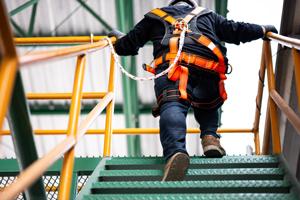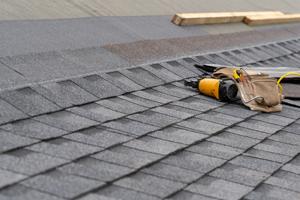Work in confined spaces
Confined spaces are not always recognized, nor are the related hazards easily identified and addressed. Confined spaces can be particularly dangerous if proper precautions are not followed. Employers can help safeguard their workers by adequately preparing and training workers on the issues and hazards inherent with confined space operations. The following actions should be addressed by management:
- Know the OSHA requirements for work in confined spaces.
- Conduct a job hazard assessment that identifies the types of confined spaces for each project and determines if the confined spaces are "permit-required." Permit-required confined spaces can include:
- Excavations and trenches
- Manholes and condenser pits
- Pipe assemblies
- Ventilation ducts
- Tanks and containment cavities
- Electrical transformers
- Sumps and heat sinks
- Underground vaults
- Identify the hazards (inherent and induced) associated with each confined space. Such hazards include:
- Confined spaces within a confined space — one space entering another space
- Communication and lighting problems
- Entry and exit
- Thermal effects
- Oxygen-deficient atmospheres
- Explosive or toxic gases, vapors or fumes
- Biological hazards
- Falling materials
- Noise
- Identify required personal protection equipment (PPE) and provide training in their use.
- Conduct frequent refresher training on safety procedures.
- Train and appoint entrants, attendants and rescue personnel.
- Establish general and specific emergency procedures and plans for each project activity.
This material is provided for informational purposes only and does not provide any coverage or guarantee loss prevention. The examples in this material are provided as hypothetical and for illustration purposes only. The Hanover Insurance Company and its affiliates and subsidiaries (“The Hanover”) specifically disclaim any warranty or representation that acceptance of any recommendations contained herein will make any premises, or operation safe or in compliance with any law or regulation. By providing this information to you. The Hanover does not assume (and specifically disclaims) any duty, undertaking or responsibility to you. The decision to accept or implement any recommendation(s) or advice contained in this material must be made by you.
LC NOV 2018 LC 12-294
171-0938 (2/14)
Related resources
Work in confined spaces
Confined spaces are not always recognized, nor are the related hazards easily identified and addressed. Confined spaces can be particularly dangerous if proper precautions are not followed. Employers can help safeguard their workers by adequately preparing and training workers on the issues and hazards inherent with confined space operations. The following actions should be addressed by management:
- Know the OSHA requirements for work in confined spaces.
- Conduct a job hazard assessment that identifies the types of confined spaces for each project and determines if the confined spaces are "permit-required." Permit-required confined spaces can include:
- Excavations and trenches
- Manholes and condenser pits
- Pipe assemblies
- Ventilation ducts
- Tanks and containment cavities
- Electrical transformers
- Sumps and heat sinks
- Underground vaults
- Identify the hazards (inherent and induced) associated with each confined space. Such hazards include:
- Confined spaces within a confined space — one space entering another space
- Communication and lighting problems
- Entry and exit
- Thermal effects
- Oxygen-deficient atmospheres
- Explosive or toxic gases, vapors or fumes
- Biological hazards
- Falling materials
- Noise
- Identify required personal protection equipment (PPE) and provide training in their use.
- Conduct frequent refresher training on safety procedures.
- Train and appoint entrants, attendants and rescue personnel.
- Establish general and specific emergency procedures and plans for each project activity.
This material is provided for informational purposes only and does not provide any coverage or guarantee loss prevention. The examples in this material are provided as hypothetical and for illustration purposes only. The Hanover Insurance Company and its affiliates and subsidiaries (“The Hanover”) specifically disclaim any warranty or representation that acceptance of any recommendations contained herein will make any premises, or operation safe or in compliance with any law or regulation. By providing this information to you. The Hanover does not assume (and specifically disclaims) any duty, undertaking or responsibility to you. The decision to accept or implement any recommendation(s) or advice contained in this material must be made by you.
LC NOV 2018 LC 12-294
171-0938 (2/14)
Related resources
Work in confined spaces
Confined spaces are not always recognized, nor are the related hazards easily identified and addressed. Confined spaces can be particularly dangerous if proper precautions are not followed. Employers can help safeguard their workers by adequately preparing and training workers on the issues and hazards inherent with confined space operations. The following actions should be addressed by management:
- Know the OSHA requirements for work in confined spaces.
- Conduct a job hazard assessment that identifies the types of confined spaces for each project and determines if the confined spaces are "permit-required." Permit-required confined spaces can include:
- Excavations and trenches
- Manholes and condenser pits
- Pipe assemblies
- Ventilation ducts
- Tanks and containment cavities
- Electrical transformers
- Sumps and heat sinks
- Underground vaults
- Identify the hazards (inherent and induced) associated with each confined space. Such hazards include:
- Confined spaces within a confined space — one space entering another space
- Communication and lighting problems
- Entry and exit
- Thermal effects
- Oxygen-deficient atmospheres
- Explosive or toxic gases, vapors or fumes
- Biological hazards
- Falling materials
- Noise
- Identify required personal protection equipment (PPE) and provide training in their use.
- Conduct frequent refresher training on safety procedures.
- Train and appoint entrants, attendants and rescue personnel.
- Establish general and specific emergency procedures and plans for each project activity.
This material is provided for informational purposes only and does not provide any coverage or guarantee loss prevention. The examples in this material are provided as hypothetical and for illustration purposes only. The Hanover Insurance Company and its affiliates and subsidiaries (“The Hanover”) specifically disclaim any warranty or representation that acceptance of any recommendations contained herein will make any premises, or operation safe or in compliance with any law or regulation. By providing this information to you. The Hanover does not assume (and specifically disclaims) any duty, undertaking or responsibility to you. The decision to accept or implement any recommendation(s) or advice contained in this material must be made by you.
LC NOV 2018 LC 12-294
171-0938 (2/14)
Related resources
Work in confined spaces
Confined spaces are not always recognized, nor are the related hazards easily identified and addressed. Confined spaces can be particularly dangerous if proper precautions are not followed. Employers can help safeguard their workers by adequately preparing and training workers on the issues and hazards inherent with confined space operations. The following actions should be addressed by management:
- Know the OSHA requirements for work in confined spaces.
- Conduct a job hazard assessment that identifies the types of confined spaces for each project and determines if the confined spaces are "permit-required." Permit-required confined spaces can include:
- Excavations and trenches
- Manholes and condenser pits
- Pipe assemblies
- Ventilation ducts
- Tanks and containment cavities
- Electrical transformers
- Sumps and heat sinks
- Underground vaults
- Identify the hazards (inherent and induced) associated with each confined space. Such hazards include:
- Confined spaces within a confined space — one space entering another space
- Communication and lighting problems
- Entry and exit
- Thermal effects
- Oxygen-deficient atmospheres
- Explosive or toxic gases, vapors or fumes
- Biological hazards
- Falling materials
- Noise
- Identify required personal protection equipment (PPE) and provide training in their use.
- Conduct frequent refresher training on safety procedures.
- Train and appoint entrants, attendants and rescue personnel.
- Establish general and specific emergency procedures and plans for each project activity.
This material is provided for informational purposes only and does not provide any coverage or guarantee loss prevention. The examples in this material are provided as hypothetical and for illustration purposes only. The Hanover Insurance Company and its affiliates and subsidiaries (“The Hanover”) specifically disclaim any warranty or representation that acceptance of any recommendations contained herein will make any premises, or operation safe or in compliance with any law or regulation. By providing this information to you. The Hanover does not assume (and specifically disclaims) any duty, undertaking or responsibility to you. The decision to accept or implement any recommendation(s) or advice contained in this material must be made by you.
LC NOV 2018 LC 12-294
171-0938 (2/14)





